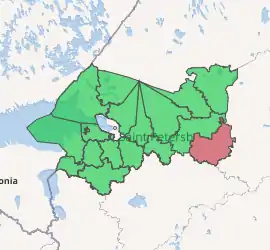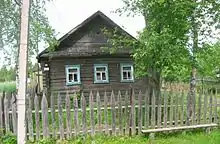Boksitogorsky District
Boksitogorsky District (Russian: Бокситого́рский райо́н) is an administrative[1] and municipal[7] district (raion), one of the seventeen in Leningrad Oblast, Russia. It is located in the southeast of the oblast and borders with Tikhvinsky District in the north and west, Babayevsky District of Vologda Oblast in the east, Chagodoshchensky District of Vologda Oblast in the southeast, Khvoyninsky District of Novgorod Oblast in the south, and with Lyubytinsky District of Novgorod Oblast in the southwest. The area of the district is 7,200 square kilometers (2,800 sq mi).[3] Its administrative center is the town of Boksitogorsk.[1] Population (excluding the administrative center): 15,695 (2010 Census);[4] 17,698 (2002 Census);[9] 49,452 (1989 Census).[10][11]
Boksitogorsky District
Бокситогорский район | |
|---|---|
 Source of the Volozhba River, in Boksitogorsky District | |
 Flag .svg.png.webp) Coat of arms | |

Location of Boksitogorsky District in Leningrad Oblast | |
| Coordinates: 59°29′N 34°40′E | |
| Country | Russia |
| Federal subject | Leningrad Oblast[1] |
| Established | July 25, 1952[2] |
| Administrative center | Boksitogorsk[1] |
| Area | |
| • Total | 7,200 km2 (2,800 sq mi) |
| Population | |
| • Total | 15,695 |
| • Estimate (2018)[5] | 50,019 (+218.7%) |
| • Density | 2.2/km2 (5.6/sq mi) |
| • Urban | 23.0% |
| • Rural | 77.0% |
| Administrative structure | |
| • Administrative divisions | 2 Settlement municipal formations (towns), 1 Settlement municipal formations (urban-type settlements), 7 Settlement municipal formations (rural settlements) |
| • Inhabited localities[1] | 2 Cities/towns, 1 Urban-type settlements[6], 258 Rural localities |
| Municipal structure | |
| • Municipally incorporated as | Boksitogorsky Municipal District[7] |
| • Municipal divisions[7] | 3 Urban settlements, 7 Rural settlements |
| Time zone | UTC+3 (MSK |
| OKTMO ID | 41603000 |
| Website | http://www.boksitogorsk.ru/ |
Geography
The district is located on the Tikhvin Ridge, which separates the basins of the Baltic and Caspian Seas. The altitudes range from 150 to 250 meters (490 to 820 ft) above sea level. The western portion of the district is mostly flat with the altitudes between 50 and 100 meters (160 and 330 ft) above sea level. The district has deposits of bauxite, limestone, dolomite, and peat.
The western part of the district lies in the basin of the Syas River, a tributary of Lake Ladoga. The biggest tributaries of the Syas within the district are the Tikhvinka and the Volozhba. The northeastern part of the district belongs to the basin of the Pasha River, a tributary of the Svir, another major tributary of Lake Ladoga. The center and the southwest of the district lie in the basins of the Kolp River, a tributary of the Suda, and the Chagodoshcha, a tributary of the Mologa. Both the Kolp and the Chagodoshcha originate in the district and are a part of the Volga River's basin.
A considerable part of the district is covered with swamps. There are many lakes, especially in the east of the district.[3]
The Ragusha River, a tributary of the Volozhba in the south of the district, in the basin of the Syas River, disappears underground for about 4 kilometers (2.5 mi) and then reappears. This area is protected as a natural monument.[12]
History

The area was populated by the Finno-Ugric peoples, whose descendants, Vepsians, still live in the district. Until the 15th century, it was a part of the Novgorod Republic. In the 13th century, Antony Dymsky, a monk looking for a secluded area, founded a monastery, which is currently known as Antoniyevo-Dymsky Monastery. The territory was included into Obozerskaya Pyatina, one of the pyatinas which Novgorod lands were divided into. After the fall of the republic, the region was, together will all of the Novgorod lands, annexed by the Grand Duchy of Moscow.
In the course of the administrative reform carried out in 1708 by Peter the Great, the territory was included into Ingermanland Governorate (known since 1710 as Saint Petersburg Governorate). In 1727, separate Novgorod Governorate was split off. In 1776, the area was transferred to Novgorod Viceroyalty. In 1796, the viceroyalty was abolished, and the territory, which was split between Tikhvinsky and Ustyuzhensky Uyezds, was transferred to Novgorod Governorate. Until the end of the 19th century, the area was sparsely populated. In 1802, the Tikhvinskaya water system, which connected the basins of the Neva and the Volga, was opened. A railroad was built in the end of the 19th century. In 1916, bauxite deposits were discovered.[13] In 1918, the area was transferred to newly established Cherepovets Governorate.
On August 1, 1927, the uyezds were abolished and the territory was split between Tikhvinsky, Yefimovsky, and Pikalyovsky Districts. The governorates were also abolished. Tikhvinsky and Pikalyovsky Districts were a part of Leningrad Okrug of Leningrad Oblast, whereas Yefimovsky District was a part of Cherepovets Okrug of Leningrad Oblast. On July 23, 1930, the okrugs were abolished as well, and the districts were directly subordinated to the oblast. In 1941, during World War II, German troops tried to encircle Leningrad. In November 1941, they occupied the town of Tikhvin and held it for a month. The current area of Boksitogorsky District was not occupied, but for several months it was immediately adjacent to the front line.[13]
In 1950, Boksitogorsk was granted town status and on July 25, 1952, Boksitogorsky District with the administrative center in the town of Boksitogorsk was established. It included areas which previously belonged to Tikhvinsky and Yefimovsky Districts. In 1954, the urban-type settlement of Pikalyovo was granted town status. On February 1, 1963, in the course of Nikita Khrushchev's administrative reform, the district was abolished, and the town of Boksitogorsk was elevated in status to that of a town of oblast significance. On January 12, 1965, the district was re-established.[2] In 1991, Pikalyovo was granted the status of a town of oblast significance.
On August 1, 1927, Yefimovsky District with the administrative center in the settlement of Yefimovsky was established as a part of Cherepovets Okrug of Leningrad Oblast. On February 1, 1963, the district was abolished, and, after a short period, merged into Boksitogorsky District.[14]
On August 1, 1927, Pikalyovsky District with the administrative center in the selo of Pikalyovo was also established as a part of Leningrad Okrug of Leningrad Oblast. In 1932, Pikalyovsky District was abolished and split between Yefimovsky, Tikhvinsky, Dregelsky, Kapshinsky, and Khvoyninsky Districts. Dregelsky District is currently a part of Lyubytinsky District of Novgorod Oblast.[15] The rest of the territory of former Pikalyovsky District is currently a part of Boksitogorsky District.
Another district established on August 1, 1927 as a part of Leningrad Okrug of Leningrad Oblast was Kapshinsky District, with the administrative center in the settlement of Shugozero. On February 1, 1963, the district was abolished and, after a short period, split between Boksitogorsky and Tikhvinsky Districts.[16]
Administrative and municipal divisions
As an administrative division, the district is divided into ten settlement municipal formations.[1] As a municipal division, the district is incorporated as Boksitogorsky Municipal District and is divided into three urban and seven rural settlements.[7]
Economy
Industry
The economy of Boksitogorsky District is based on timber industry and food industry.[17]
Agriculture
In the district, there are two mid-scale farms and four enterprises engaged in fish farming. The main agricultural specializations are cattle breeding and trout farming.[18]
Transportation
A railroad connecting St. Petersburg and Vologda crosses the district from west to east. Yefimovsky and Podborovye are the principal stations within the district. A secondary line connects Podborovye with Chagoda and Kabozha, thus making a connection to the line between St. Petersburg and Sonkovo.
A114 highway, connecting Vologda to Cherepovets and St. Petersburg, crosses the district as well. A road branches off in Dymi and runs through Boksitogorsk to the settlement of Nebolchi in Novgorod Oblast. There are also local roads.
A considerable part of the Tikhvinskaya water system, one of the waterways constructed in the early 19th century to connect the basins of the Volga and Neva Rivers, lies in Boksitogorsky District. The waterway runs from the Syas upstream the Tikhvinka River. Lake Yelgino is connected by the Tikhvin Canal, 6 kilometers (3.7 mi) with the upper course of the Volchina River. The waterway then follows downstream the Gorun River, the Chagodoshcha River, and the Mologa River. Currently, it is not used for any commercial navigation.[19]
Culture and recreation

The district contains nine cultural heritage monuments of federal significance as well as sixty-eight objects classified as cultural and historical heritage of local significance.[20] Five of the federal monuments are related to the events connected with the times of the Great Patriotic War of 1941–1945. The other four are the wooden Church of Archangel Michael in the village of Nosovo, the wooden Church of the Nativity of the Theotokos in the village of Listvenka, the grave of a military engineer Viktor Krenke in the village of Kolbeki, and a monument commemorating the visits of Peter the Great between 1712 and 1716 in the urban-type settlement of Yefimovsky.
The only museum in the district is located in the village of Astrachi and highlights the events of 1941, when the German Army tried to encircle Leningrad and was stopped in this area.[21]
References
Notes
- Oblast Law #32-oz
- Бокситогорский район (июль 1952 г.) (in Russian). Система классификаторов исполнительных органов государственной власти Санкт-Петербурга. Archived from the original on September 27, 2013. Retrieved May 14, 2012.
- Географическое положение (in Russian). Бокситогорский муниципальный район. Archived from the original on August 8, 2014. Retrieved June 4, 2012.
- Russian Federal State Statistics Service (2011). "Всероссийская перепись населения 2010 года. Том 1" [2010 All-Russian Population Census, vol. 1]. Всероссийская перепись населения 2010 года [2010 All-Russia Population Census] (in Russian). Federal State Statistics Service.
- "26. Численность постоянного населения Российской Федерации по муниципальным образованиям на 1 января 2018 года". Federal State Statistics Service. Retrieved January 23, 2019.
- The count of urban-type settlements may include the work settlements, the resort settlements, the suburban (dacha) settlements, as well as urban-type settlements proper.
- Law #78-oz
- "Об исчислении времени". Официальный интернет-портал правовой информации (in Russian). June 3, 2011. Retrieved January 19, 2019.
- Russian Federal State Statistics Service (May 21, 2004). "Численность населения России, субъектов Российской Федерации в составе федеральных округов, районов, городских поселений, сельских населённых пунктов – районных центров и сельских населённых пунктов с населением 3 тысячи и более человек" [Population of Russia, Its Federal Districts, Federal Subjects, Districts, Urban Localities, Rural Localities—Administrative Centers, and Rural Localities with Population of Over 3,000] (XLS). Всероссийская перепись населения 2002 года [All-Russia Population Census of 2002] (in Russian).
- "Всесоюзная перепись населения 1989 г. Численность наличного населения союзных и автономных республик, автономных областей и округов, краёв, областей, районов, городских поселений и сёл-райцентров" [All Union Population Census of 1989: Present Population of Union and Autonomous Republics, Autonomous Oblasts and Okrugs, Krais, Oblasts, Districts, Urban Settlements, and Villages Serving as District Administrative Centers]. Всесоюзная перепись населения 1989 года [All-Union Population Census of 1989] (in Russian). Институт демографии Национального исследовательского университета: Высшая школа экономики [Institute of Demography at the National Research University: Higher School of Economics]. 1989 – via Demoscope Weekly.
- The 1989 results include the population of the town of Pikalyovo.
- Рыжиков, Алексей (February 1992). Ледопад на Рагуше (in Russian). Вокруг Света. Retrieved June 4, 2012.
- История района (in Russian). Бокситогорский муниципальный район. Archived from the original on January 11, 2012. Retrieved June 4, 2012.
- "Archived copy" Ефимовский район (август 1927 г. - январь 1965 г.) (in Russian). Система классификаторов исполнительных органов государственной власти Санкт-Петербурга. Archived from the original on August 8, 2014. Retrieved May 14, 2012.CS1 maint: archived copy as title (link)
- "Archived copy" Пикалевский район (август 1927 г. - январь 1932 г.) (in Russian). Система классификаторов исполнительных органов государственной власти Санкт-Петербурга. Archived from the original on March 4, 2016. Retrieved May 14, 2012.CS1 maint: archived copy as title (link)
- "Archived copy" Капшинский район (август 1927 г. - февраль 1963 г.) (in Russian). Система классификаторов исполнительных органов государственной власти Санкт-Петербурга. Archived from the original on August 8, 2014. Retrieved May 14, 2012.CS1 maint: archived copy as title (link)
- Перечень основных предприятий, действующих на территории Бокситогорского муниципального района (in Russian). Бокситогорский муниципальный район. Archived from the original on June 15, 2013. Retrieved June 4, 2012.
- Сельское хозяйство (in Russian). Бокситогорский муниципальный район. Archived from the original on June 15, 2013. Retrieved May 13, 2012.
- Хрусталев, М. Ю. (1999). По Тихвинской водной системе. Из истории водных коммуникаций и судоходства. Чагода: Историко-краеведческий альманах (in Russian). Vologda: Ардвисура. Retrieved November 17, 2012.
- Памятники истории и культуры народов Российской Федерации (in Russian). Russian Ministry of Culture. Retrieved June 2, 2016.
- Астрача, 1941. Музей Боевой Славы (in Russian). 47 новостей (47 news). Archived from the original on June 21, 2012. Retrieved June 4, 2012.
Sources
- Законодательное собрание Ленинградской области. Областной закон №32-оз от 15 июня 2010 г. «Об административно-территориальном устройстве Ленинградской области и порядке его изменения», в ред. Областного закона №23-оз от 8 мая 2014 г. «Об объединении муниципальных образований "Приморское городское поселение" Выборгского района Ленинградской области и "Глебычевское сельское поселение" Выборгского района Ленинградской области и о внесении изменений в отдельные Областные законы». Вступил в силу со дня официального опубликования. Опубликован: "Вести", №112, 23 июня 2010 г. (Legislative Assembly of Leningrad Oblast. Oblast Law #32-oz of June 15, 2010 On the Administrative-Territorial Structure of Leningrad Oblast and on the Procedures for Its Change, as amended by the Oblast Law #23-oz of May 8, 2014 On Merging the Municipal Formations of "Primorskoye Urban Settlement" in Vyborgsky District of Leningrad Oblast and "Glebychevskoye Rural Settlement" in Vyborgsky District of Leningrad Oblast and on Amending Various Oblast Laws. Effective as of the day of the official publication.).
- Законодательное собрание Ленинградской области. Областной закон №78-оз от 26 октября 2004 г. «Об установлении границ и наделении соответствующим статусом муниципального образования Бокситогорский муниципальный район и муниципальных образований в его составе», в ред. Областного закона №22-оз от 8 мая 2014 г. «Об объединении муниципальных образований Анисимовское сельское поселение Бокситогорского муниципального района Ленинградской области и Самойловское сельское поселение Бокситогорского муниципального района Ленинградской области и о внесении изменений в отдельные Областные законы». Вступил в силу через 10 дней со дня официального опубликования (29 ноября 2004 г.). Опубликован: "Вестник Правительства Ленинградской области", №34, 19 ноября 2004 г. (Legislative Assembly of Leningrad Oblast. Oblast Law #78-oz of October 26, 2004 On Establishing the Borders of and Granting an Appropriate Status to the Municipal Formation of Boksitogorsky Municipal District and to the Municipal Formations It Comprises, as amended by the Oblast Law #22-oz of May 8, 2014 On the Merger of the Municipal Formations of Anisimovskoye Rural Settement in Boksitogorsky Municipal District of Leningrad Oblast and Samoylovskoye Rural Settlement in Boksitogorsky Municipal District of Leningrad Oblast and on Amending Various Oblast Laws. Effective as of after 10 days from the day of the official publication (November 29, 2004).).